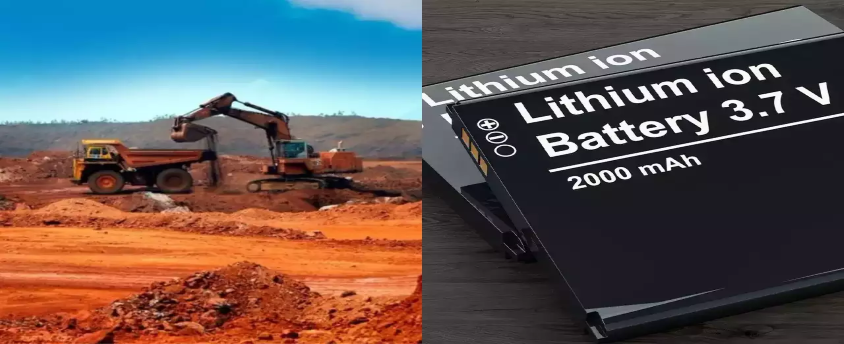Lithium Deposits in India
13, Feb 2023

Prelims level : Science & Technology
Mains level : GS-III Science & Technology - Awareness in the fields of it, Space, Computers, Robotics, Nano-Technology, Bio-Technology, Pharma Sector & Health Science
Why in News?
- The Geological Survey of India has for the first time established Lithium inferred resources of 5.9 million tonnes in the Salal-Haimana area of Reasi District of Jammu & Kashmir.
- This report along with 15 other resource-bearing geological reports were handed over to respective state governments on 9th February 2023 at the 62nd Central Geological Programming board meeting.
- Out of these 51 mineral blocks, 5 blocks pertain to gold and other blocks pertain to commodities like potash, molybdenum, base metals, etc. spread across 11 states of Jammu & Kashmir (UT), Andhra Pradesh, Chhattisgarh, Gujarat, Jharkhand, Karnataka, Madhya Pradesh, Odisha, Rajasthan, Tamil Nadu and Telangana.
- The blocks were prepared based on the work carried out by GSI from field seasons 2018-19 to till date.
- Significance of Lithium Discovery in India:
- As per the government, lithium reserves have been found for the first time in the country in Jammu and Kashmir.The Atomic Minerals Directorate for Exploration and Research (AMD) under the Department of Atomic Energy, had earlier conducted preliminary surveys that had shown the presence of lithium resources of 1,600 tonnes in the igneous rocks of the Marlagalla–Allapatna region of Karnataka’s Mandya district.
- One of the essential components of electric vehicle (EV) batteries is lithium. The demand for lithium is increasing quickly as more and more people switch from driving gasoline and diesel automobiles to electric ones.
- Lithium is also used in batteries for gadgets like laptops and mobile phones. It has also found application in the glass and ceramics industries.Therefore, lithium has been dubbed “white gold” for its widespread usage in items indispensable to modern-day living.
- The demand for lithium is outstripping availability in the world already. According to a prediction by the International Energy Agency, a lithium shortage could occur by 2025.
- Lithium resources are concentrated in a few places. Around 50 percent of the world’s lithium deposits are found in the salt flats of Argentina, Bolivia, and Chile. Australia also has around 2.7 million tonnes of lithium resources.
- China controls 60 percent of the world’s capacity for processing raw lithium products into batteries. With limited supply and rising prices, the discovery of Lithium in India is crucial as it currently relies on imports to meet its mineral demand, including lithium, nickel, and cobalt.Over 165 crore lithium batteries are estimated to have been imported into India between FY17 and FY20 at an estimated import bill of upwards of $3.3 billion.
- It is critical as India is trying to wean itself off dependence on China for crucial battery materials and position itself as an alternative in the electric vehicle supply chain.
- Although the lithium find in J & K, in inferred terms, is comparatively small, it is expected to give a big push to the government’s plans of expanding into the EV market.
- The proven reserves in Bolivia are 21 million tonnes, 17 million tonnes in Argentina, Chile (9 million tonnes) 6.3 million tonnes in Australia, and 4.5 million tonnes in China.
Lithium Triangle:
- Steps taken by the Indian government to secure access to Lithium reserves:
- The government has directed three state-owned mineral companies (National Aluminium Company (Nalco), Hindustan Copper (HCL) and Mineral Exploration Corp. Ltd (MECL)) to team up for a new venture tasked with scouting and acquiring strategic mineral assets abroad.
- Khanij Bidesh India Ltd., (KABIL), a consortium of three PSU companies mentioned above is also prospecting to secure minerals from Argentina and Chile.
- Also, high-level visits like the President of India visiting these South American countries demonstrate a proactive and aggressive stance to secure lithium sourcing.
- India has leveraged its way into the Bolivian lithium reserves after signing a Memorandum of Understanding (MoU) in Bolivia for the development and industrial use of lithium.
- India has set up a National Mission on Transformative Mobility and Battery Storage.
- An inter-ministerial steering committee has also been set up which is chaired by NITI Aayog CEO Amitabh Kant.
- The government set up R & D and technology development centres for indigenous lithium-ion battery manufacturing plants: BHEL and LIBCOIN to build India’s first Lithium-Ion Giga Factory.In the first phase, Rs 165 crore will be invested to produce li-ion cells having a total storage capacity of 200,000 Ah (Ampere hour) per day.
Lithium:
- Lithium is a non-ferrous, silvery-white alkali metal.
- Under standard conditions, it is the least dense metal and the least dense solid element.
- Like all alkali metals, lithium is highly reactive and flammable, and must be stored in vacuum, inert atmosphere, or inert liquid such as purified kerosene or mineral oil.
- It never occurs freely in nature, but only in (usually ionic) compounds, such as pegmatitic minerals, which were once the main source of lithium.
- Due to its solubility as an ion, it is present in ocean water and is commonly obtained from brines. Lithium metal is isolated electrolytically from a mixture of lithium chloride and potassium chloride.Lithium can be extracted in different ways, depending on the type of the deposit — generally either through solar evaporation of large brine pools or from hard-rock extraction of the ore.
- In India, Lithium can be recovered from brines of Sambhar and Pachpadra areas in Rajasthan, and Rann of Kutch, Gujarat.
- The major mica belts located in Rajasthan, Bihar and Andhra Pradesh and the pegmatite belts in Odisha, Chhattisgarh, alongside rock mining being undertaken at Mandya, Karnataka, are other potential geological domains.






